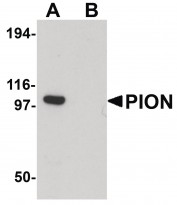ARG54667
anti-GSAP / PION antibody
anti-GSAP / PION antibody for ELISA,ICC/IF,IHC-Formalin-fixed paraffin-embedded sections,Western blot and Human,Mouse,Rat
Developmental Biology antibody; Gene Regulation antibody; Neuroscience antibody
Overview
| Product Description | Rabbit Polyclonal antibody recognizes GSAP / PION |
|---|---|
| Tested Reactivity | Hu, Ms, Rat |
| Tested Application | ELISA, ICC/IF, IHC-P, WB |
| Specificity | Multiple isoforms of PION are known to exist. PION antibody is predicted to not cross-react with other F-box protein family members. |
| Host | Rabbit |
| Clonality | Polyclonal |
| Isotype | IgG |
| Target Name | GSAP / PION |
| Immunogen | Synthetic peptide (19 aa) within aa. 770-820 of Human PION. |
| Conjugation | Un-conjugated |
| Alternate Names | Protein pigeon homolog; GSAP-16K; GSAP; PION; Gamma-secretase-activating protein |
Application Instructions
| Application Suggestion |
|
||||||||||
|---|---|---|---|---|---|---|---|---|---|---|---|
| Application Note | * The dilutions indicate recommended starting dilutions and the optimal dilutions or concentrations should be determined by the scientist. | ||||||||||
| Positive Control | EL4 Cell Lysate |
Properties
| Form | Liquid |
|---|---|
| Purification | Affinity purification with immunogen. |
| Buffer | PBS and 0.02% Sodium azide |
| Preservative | 0.02% Sodium azide |
| Concentration | 1 mg/ml |
| Storage Instruction | For continuous use, store undiluted antibody at 2-8°C for up to a week. For long-term storage, aliquot and store at -20°C or below. Storage in frost free freezers is not recommended. Avoid repeated freeze/thaw cycles. Suggest spin the vial prior to opening. The antibody solution should be gently mixed before use. |
| Note | For laboratory research only, not for drug, diagnostic or other use. |
Bioinformation
| Database Links |
Swiss-port # A4D1B5 Human Gamma-secretase-activating protein Swiss-port # Q3TCV3 Mouse Gamma-secretase-activating protein |
|---|---|
| Gene Symbol | GSAP |
| Gene Full Name | gamma-secretase activating protein |
| Background | PION Antibody: Accumulation of the amyloid-beta peptide (Abeta) in the cerebral cortex is a critical event in the pathogenesis of Alzheimer's disease. The beta-amyloid protein precursor (APP) is cleaved by one of two beta-secretases (BACE and BACE2), producing a soluble derivative of the protein and a membrane anchored 99 -amino acid carboxy-terminal fragment (C99). The C99 fragment serves as substrate for gamma-secretase to generate the 4 kDa amyloid-beta peptide (Abeta), which is deposited in the Alzheimer's disease patient's brains. PION, or GSAP, selectively increases amyloid-beta production through a mechanism involving its interaction with both gamma-secretase and the APP C-terminal fragment, suggesting that PION may be a potential therapeutic target for the treatment of Alzheimer's disease. | |
| Research Area | Developmental Biology antibody; Gene Regulation antibody; Neuroscience antibody |
| Calculated MW | 98 kDa |
| PTM | The protein is first synthesized as a holoprotein form of 98 kDa and rapidly processed into the gamma-secretase-activating protein 16 kDa C-terminal form, which constitutes the predominant form. |
Images (3) Click the Picture to Zoom In
-
ARG54667 anti-PION antibody ICC/IF image
Immunofluorescence: human brain cells stained with ARG54667 anti-PION antibody at 20 μg/ml.
-
ARG54667 anti-PION antibody IHC image
Immunohistochemistry: human brain tissue stained with ARG54667 anti-PION antibody at 5 μg/ml.
-
ARG54667 anti-PION antibody WB image
Western blot: EL4 cell lysate stained with ARG54667 anti-PION antibody at 0.25 μg/ml in (A) the absence and (B) the presence of blocking peptide.








